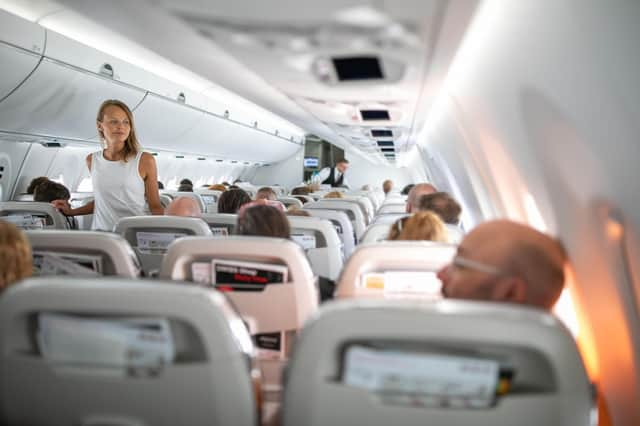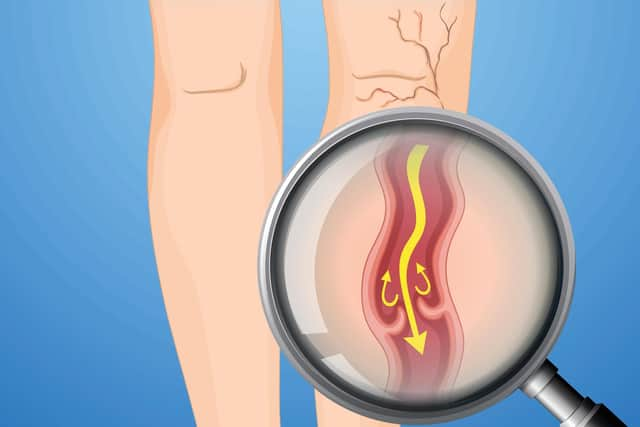How to reduce your chances of getting DVT on a long flight - Scotland on Sunday Travel


Whether you’re jetting off for some sun or a family break, if you’ve got long-haul flights booked this year, it’s important to understand how to prevent deep vein thrombosis (DVT) while you’re in the air.
Follow some simple do’s and don’ts to reduce your risk of developing a blood clot forming in your leg, causing pain and potentially ruining your holiday.
Advertisement
Hide AdAdvertisement
Hide AdTo mark DVT Awareness Month in March, doctors explain everything you need to know about preventing the condition…


What is DVT?
“Deep vein thrombosis is the formation of a blood clot, generally in the lower limbs, but it can occasionally occur in upper limbs,” says personal physician and private home visiting GP Dr Suhail Hussain (drsuhailhussain.com).
The condition is believed to affect around one in every 1,000 people in the UK, and usually only occurs in one leg.
“Possible symptoms can include a painful or tender leg for no obvious reason, above knee, below knee or both,” says Professor Mark Whiteley, leading venous surgeon and founder of The Whiteley Clinic (thewhiteleyclinic.co.uk).


Swelling can occur from the ankle upwards or the whole leg, he says. “Other symptoms include a heavy ache, especially on standing or walking; warm skin in the area of swelling; and sometimes the skin can be a bit redder.”
Generally, DVT is not a major problem if diagnosed and treated immediately, but complications can occur.
“It can develop into PE (pulmonary embolism), a blood clot on the lung which can be life-threatening, so [we] should not ignore signs and symptoms of DVT,” Hussain says.
DVT is generally diagnosed via an ultrasound scan. The main treatment is anticoagulant medicine such as warfarin or rivaroxaban.
Advertisement
Hide AdAdvertisement
Hide Ad“If there are recurrent DVTs in the same leg, the deep veins can become scarred and stop working properly,” Whiteley says.
“This causes ‘post-thrombotic syndrome’ (PTS), which can cause chronic pain and swelling of the leg, with discolouration and often leg ulcers.”
Why does DVT occur on long-haul flights?
One of the risk factors for DVT is long periods of inactivity.
“According to the latest research from NICE, the risk of developing DVT is increased two- or threefold after long-haul flights, meaning over four hours,” Whiteley explains.
Other medical factors can play a part such as a family history of DVT, large varicose veins or cancer, pregnancy or recent major surgery.
Stretch your legs
The most important thing you can do is not stay in your seat for the whole flight.
“Walk in the aisle at least once per hour, particularly if the flight is over four hours,” says Whiteley.
Hussain recommends walking more frequently: “Get up around every 20 to 30 mins if possible.”
Advertisement
Hide AdAdvertisement
Hide AdWhile seated, keep your legs moving with calf exercises, such as flexing and extending ankles.
Stay hydrated
Hydration is also key for preventing DVT, Whiteley says. “Dehydration affects the constituents of the blood, making blood thicker and more ‘sticky’ – blood flows at a slower rate in veins than in arteries and can increase the chances of developing a blood clot in the veins.”
Sticking primarily to H2O rather than alcohol.
“Drink plenty of fluids including water, diluted squash, herbal teas and fruit juice, especially if you have other risk factors for blood clots,” Whiteley advises.
Tea and coffee contain caffeine, which causes you to lose water. Alcohol can make dehydration worse and should be consumed at a minimum.”
Hussain recommends avoiding sleeping pills or alcohol that will cause you to drift off. “If you’re sleeping you can’t get up,” he adds.
Wear compression socks
“Wear compression stockings providing 15 to 30mmHg pressure at the ankle,” while traveling, says Hussain, which means ‘millimetres of mercury’, or the compression level.
“Compression socks speed up the flow of blood in the veins and reduce the risk of the blood clotting,” Whiteley suggests.
“Research has confirmed ‘travel socks’ reduce the risk of developing DVT.”
Avoid flying if you’re high risk
Advertisement
Hide AdAdvertisement
Hide Ad“Once you’ve had one blood clot, the risk of a subsequent one increases,” says Hussain who advises avoiding flights if you’ve had DVT recently.
Blood thinning medication (heparin) can be given if the patient absolutely must fly.